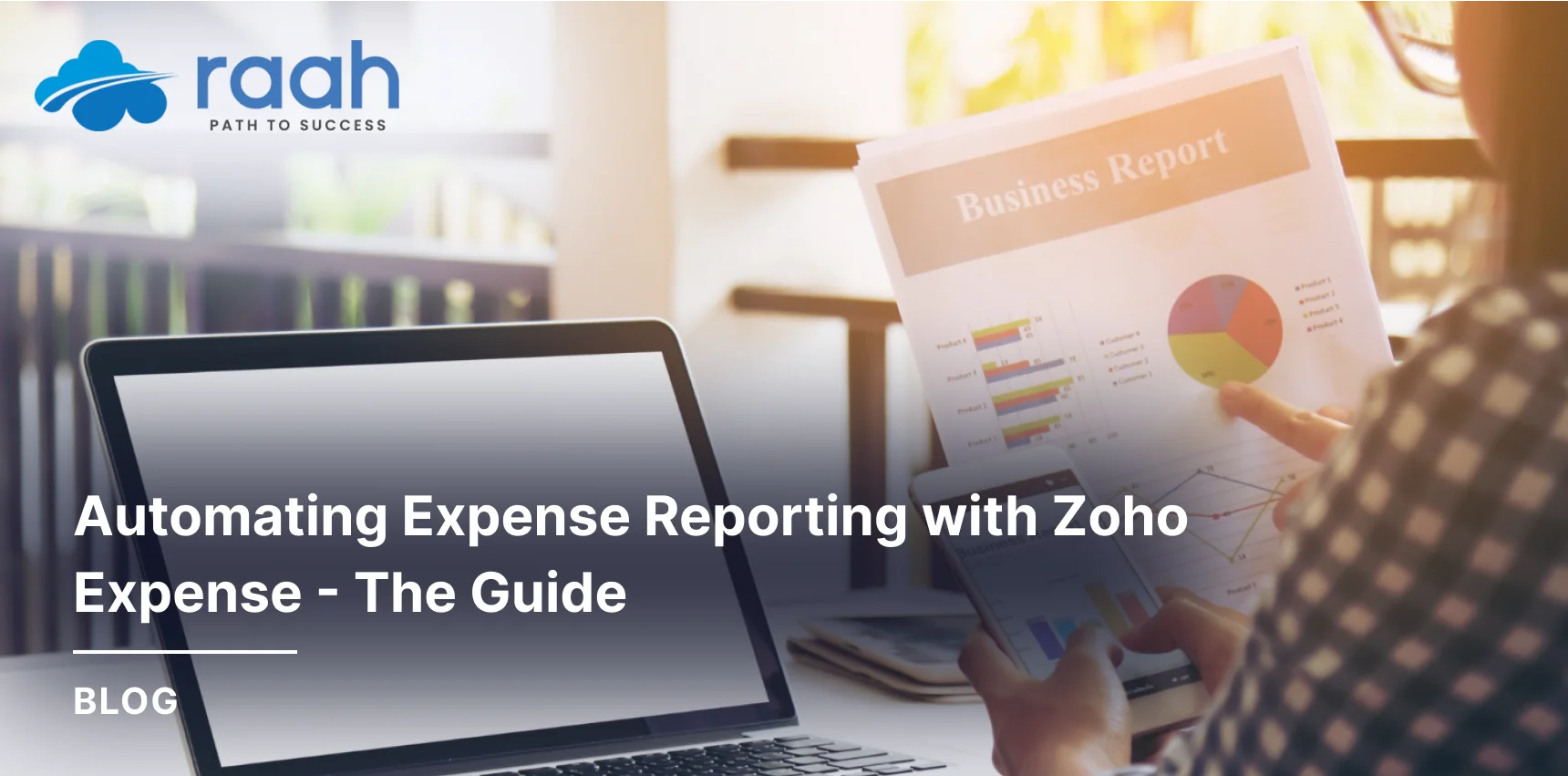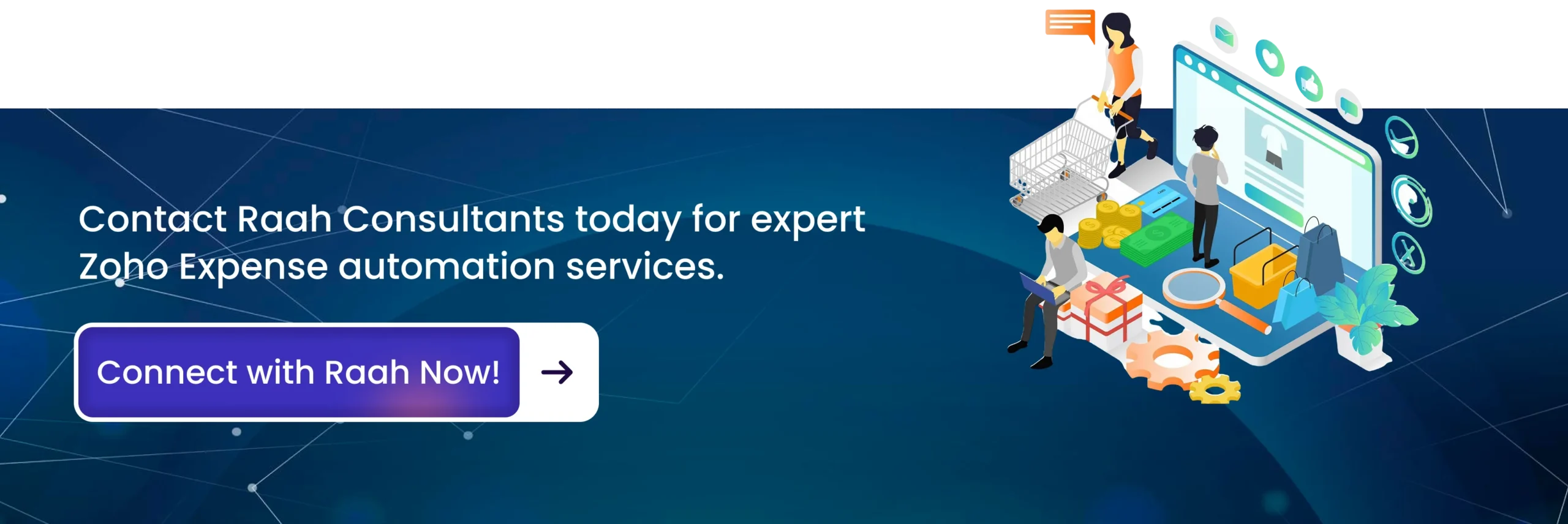
Manual expense reporting is slow, error-prone, and risky for compliance. Zoho Expense automation changes the game by digitizing every step—capturing receipts, categorizing expenses, enforcing policies, and syncing seamlessly with accounting systems like Zoho Books or QuickBooks. Features such as AI-powered receipt scanning, corporate card reconciliation, and multi-level approvals deliver speed, accuracy, and real-time visibility into business spending. Whether you're a startup or an enterprise, Zoho Expense empowers finance teams to reduce cycle times, improve compliance, and ensure employees are reimbursed quickly and fairly.
Quick Summary
Manual expense reporting is slow, error-prone, and risky for compliance. Zoho Expense automation changes the game by digitizing every step—capturing receipts, categorizing expenses, enforcing policies, and syncing seamlessly with accounting systems like Zoho Books or QuickBooks. Features such as AI-powered receipt scanning, corporate card reconciliation, and multi-level approvals deliver speed, accuracy, and real-time visibility into business spending. Whether you're a startup or an enterprise, Zoho Expense empowers finance teams to reduce cycle times, improve compliance, and ensure employees are reimbursed quickly and fairly.
Introduction
Manual expense reporting is the business equivalent of herding cats—messy, time-consuming, and prone to escape. Paper receipts get lost, spreadsheets break, policy exceptions slip through, and month-end close drags on. Small errors cascade into bigger problems: inaccurate P&L lines, late reimbursements, and compliance headaches.
That's why automation has become non-negotiable. With digital expense tracking, organizations move from reactive firefighting to proactive control—expenses are captured instantly, validated automatically, and pushed straight into accounting without manual rekeying.
Enter Zoho Expense. As part of the Zoho Finance Suite, it delivers Zoho Expense automation capabilities that shrink cycle times, boost accuracy, and bring real-time visibility to spend—without the complexity or price tag of legacy tools.
Key Takeaways
Zoho Expense automates end-to-end expense reporting, cutting manual work.
OCR-driven receipt scanning ensures accuracy and faster submissions.
Corporate card feeds and reconciliation simplify card program oversight.
Configurable approval workflows maintain strict policy compliance.
Integration with Zoho Books and QuickBooks accelerates month-end close.
What Is Zoho Expense?
A quick look at Zoho Expense in the Zoho Finance Suite
Zoho Expense sits neatly alongside Zoho Books, Zoho Inventory, Zoho Billing, and other finance apps, forming a unified ecosystem for accounting and operations. For finance leaders, that means fewer data silos and cleaner reconciliations.
Core capabilities: mobile, integrations, and compliance
Mobile first: Snap a photo of a receipt and let OCR do the heavy lifting.
Integrations: Sync with Zoho Books, QuickBooks, and popular ERP tools to keep ledgers accurate.
Compliance: Create and enforce policies for categories, per diems, tax rules, and exceptions.
How it streamlines end-to-end expense management
From receipt to reimbursement, Zoho Expense automates capture, categorization, policy checks, approvals, posting to the GL, and audit trails—cutting manual touches at every step.
Why Automate Expense Reporting?
Eliminate manual errors – Human rekeying is error-prone. OCR-driven capture and category rules reduce inaccuracies in dates, amounts, taxes, and cost centers.
Save time and lower processing costs – Automation compresses the claim-to-close cycle: fewer emails, fewer spreadsheet versions, and faster approvals.
Strengthen policy compliance – Built-in rules prevent out-of-policy claims before they hit approvers, reducing exception handling and month-end surprises.
Gain real-time visibility into spend – Dashboards and filters surface spending trends by employee, team, project, merchant, or card—so finance controls spending proactively.

Key Features of Zoho Expense Automation
Smart receipt scanning (OCR) – Point, shoot, done. The app extracts merchant, date, amount, currency, tax, and category. No more typing line by line.
Email forwarding, autoscan, and auto-report builder – E-receipts routed to a unique mailbox are auto-parsed and added to the right report. Zoho Expense can even compile reports automatically as receipts arrive.
Corporate card reconciliation – Connect corporate cards and map them to users or teams. Transaction feeds import daily, auto-match with receipts, and flag missing documentation, simplifying card program oversight.
Automated approval workflows & configurable policies – Design multi-level workflows (manager → finance → compliance) with thresholds, department-based rules, weekend/holiday flags, and mandatory fields for certain categories (like travel or client entertainment).
Multi-currency, taxes, and per diem handling – Employees can submit in local currencies while finance sees base-currency views. Taxes and per diems are applied per policy, minimizing manual edits.
Seamless integrations (Zoho Books, QuickBooks, and ERPs) – Two-way sync keeps expense categories, projects, and vendors aligned. Approved expenses post to the right GL accounts with audit trails intact.
Travel requests, advances, and mileage tracking – Pre-trip approvals, cash advances, and GPS-assisted mileage make T&E management smooth—from planning to reimbursement.
Step-by-Step: Automating Expense Reporting with Zoho Expense
Step 1 — Capture receipts (mobile, email, auto-forward)
Employees snap photos via the mobile app, drag-and-drop PDFs on desktop, or forward e-receipts to the designated expense inbox. Corporate card transactions stream in automatically.
Step 2 — Auto-scan & categorize using AI-powered OCR
The system reads merchant, amount, date, and taxes, then applies expense management rules to categorize (e.g., "Airfare," "Meals") and tag projects, cost centers, or clients.
Step 3 — Policy checks & validation
Out-of-policy items (over limits, missing receipts, restricted categories) are flagged instantly. Employees fix issues before submitting, so approvers see clean, compliant reports.
Step 4 — Approval routing with multi-level logic
Use job roles, spend thresholds, and departments to route reports. For example, anything over a set cap can auto-escalate to Finance or the CFO.
Step 5 — Auto-generated expense reports
Receipts and card charges compile into ready-to-submit reports—complete with line-item details, taxes, mileage, and attachments.
Step 6 — Sync with accounting (Zoho Books, QuickBooks, etc.)
Once approved, expenses sync to the ledger with the correct GL codes, tax treatment, and project tags. No duplicate entry.
Step 7 — Reimbursement, audit trail & analytics
Reimbursements are triggered (where applicable), and a comprehensive audit trail preserves who approved what, when, and why—making audits straightforward. Analytics expose trends and anomalies for better decision-making.
Benefits of Using Zoho Expense Automation
Faster cycle times and fewer touchpoints – From days to hours—sometimes minutes. Fewer emails, fewer reminders, and fewer bottlenecks.
Higher data accuracy – OCR + rules > spreadsheets. Cleaner data means cleaner books and less month-end cleanup.
Stronger compliance and fraud detection – Automated checks stop out-of-policy claims and highlight duplicates, suspicious merchants, or repeat exceptions.
Better employee experience and faster reimbursements – Submitting is as easy as taking a photo. Faster approvals mean happier teams and improved morale.
Scales from startups to enterprises – Start small with core automation, then expand—add card programs, advanced approvals, multi-entity setups, and ERP integrations as you grow.
CFO dashboards, analytics, and forecasting – Visualize spend by period, department, category, or vendor—and use those insights to negotiate rates, adjust budgets, and forecast cash flow.
Real-World Use Cases
🏢 SMEs streamlining routine claims
Small and midsize firms automate everyday spend—meals, supplies, local travel—cutting processing overhead without adding headcount.
🏭 Enterprises managing travel & corporate card expenses
Centralize travel costs, enforce policy, and reconcile corporate cards with confidence. Bulk approvals and advanced workflows keep pace with volume.
📱 Remote and field teams using the mobile app
Sales, service, and project teams capture digital expense tracking on the go—no more shoeboxes of receipts or end-of-month scrambles.
💼 Project-based billing and client recharges
Tag expenses to projects or clients, approve them quickly, and push billable items to invoicing to speed up revenue recognition.
Implementation Tips & Best Practices
Map policies and categories before rollout – Define categories, limits, required fields, and exception paths in writing. The clearer your policy map, the cleaner your automation.
Clean master data, roles, and permissions – Align departments, cost centers, projects, and vendor lists with your accounting system. Set role-based access to minimize accidental edits.
Change management and training – Short videos, quick-start guides, and pilot groups help adoption. Celebrate early wins and share metrics to sustain momentum.
Measure ROI with the right KPIs – Track cycle time, first-pass approval rate, % out-of-policy, missing-receipt rate, and processing cost per report. Tie improvements to hard dollar savings and soft productivity gains.
Security, Compliance & Governance
Role-based access control and approvals – Granular permissions ensure the right people see and approve the right expenses—nothing more.
Audit trails, logs, and exportability – Every action is recorded with timestamps. Export clean, well-labeled datasets for auditors or analytics.
Data retention and privacy considerations – Set retention windows aligned with company policy and regional regulations. Restrict PII access and standardize redaction policies where needed.
Why Choose Raah Consultants for Zoho Expense Implementation
Zoho-focused expertise in Finance Suite automation – Raah Consultants brings deep experience with Zoho Expense, Zoho Books, and the broader Zoho Finance Suite, aligning tools to your workflows rather than the other way around.
Tailored implementations and integrations – From corporate card setups to ERP connections, you get implementation designed for your categories, projects, tax profiles, and approval logic.
End-to-end support: setup, training, compliance configuration – Policy mapping, admin training, end-user enablement, and post-go-live optimization—so your automation keeps improving.
Cross-industry experience and success stories – Whether you're in services, SaaS, retail, manufacturing, or the non-profit sector, Raah Consultants knows the patterns that work—and the pitfalls to avoid.
Pricing & ROI Snapshot
Cost components that impact TCO
Total cost depends on user count, card program complexity, integrations (e.g., ERP), multi-entity needs, and support scope (training, policy design, and change management).
How to model ROI for your organization
Quantify:
Reduction in processing time per report
Fewer exceptions and rework
Lower audit and compliance effort
Faster reimbursements (employee satisfaction)
Improved accrual accuracy (cleaner month-end close)
When you roll these up across departments and periods, Zoho Expense automation typically pays for itself quickly—then compounds benefits as adoption deepens.
Conclusion
Automating expense reporting with Zoho Expense removes manual friction from finance workflows, improves compliance, and unlocks real-time visibility into spending. With smart receipt scanning, corporate card reconciliation, automated approvals, and tight accounting integrations, you get accurate data and faster close—without drowning in spreadsheets.

Frequently Asked Questions
Beyond simple photo capture, Zoho Expense automates categorization, policy checks, approvals, corporate card reconciliation, and accounting sync—delivering end-to-end control.
Yes. You can submit in local currencies while finance reports in base currency, with tax treatments aligned to your configured rules and policies.
Connect your corporate card program to import transactions automatically. The system matches receipts, flags missing ones, and pushes approved lines to the GL.
It actually simplifies them. You set thresholds, roles, and routing once; then approvers see only clean, compliant reports with exceptions highlighted.
Most users are productive on day one: snap, submit, done. With brief training and good policy mapping, adoption is rapid and sustained.